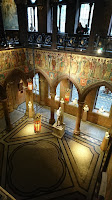Ethics expanded (from New Year, New Me?)
However, we may have an indirect ethical obligation towards animals because of their significance to other humans. For example, we should be concerned with animal welfare because it is important to consumers, and we want them to buy our products.
_________________________________________________________________________
The Utilitarian View, as aforementioned, concerns itself with the maximising human and animal well-being - the greatest good for the greatest number. A utilitarian will not only consider what is right and wrong, but also consider better and worse. All sentient being have interests, and therefore, humans and non-humans deserve equal consideration. For example, raising and milking dairy cows may be justified if the farming conditions aren't detrimental to the animals welfare, as doing so provides a benefit to humans.
A drawback to utilitarianism is that because it concerns itself with costs and benefits, it doesn't typically take an individual's interests into consideration. The interests of the herd trump the interest of the individual.
_________________________________________________________________________
The Animal Rights View are grounded on the foundation that it is unacceptable to treat a sentient being as a means to achieve a goal. No benefit can justify the violation of an animal's rights and dignity. There are three increasingly strong senses of 'Animal Rights':
1) The Moral-Status Sense - Animals have at least some moral status. Animals do not exist soley for human use, as such, they should be treated well for their own sake.
2) The Equal-Consideration Sense - The interests of humans and animals must be given equal weight from a moral persepective. Animal suffering matters as much as human suffering.
3) The Utility-trumping Sense - Animals have certain vital interests (ex. dignity) that we must not override, even in an effort to maximise benefit for society.
The challenge with the animal rights view is that the interests of individuals or groups are often opposing or mutually exclusive. What may benefit one group, could be detrimental to another.
_________________________________________________________________________
The Relational View is based on the concept that our morality grows out of our relationship with animals. Our relationship with them defines our duties towards them. For example, we have special duties towards domestic animals because they are in our care, although generally speaking, we do not have duties to wild animals.
_________________________________________________________________________
The Repsect for Nature View upholds that we have a duty to not only protect individual animals, but the species in which they belong. This view emphasizes preserving species, genetic integrity (as nature intends), ecosytems, and other collective entities. The preservation of a species is in itself morally good, and therefore, we should respect nature and its rich genetic structures.




























